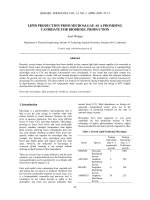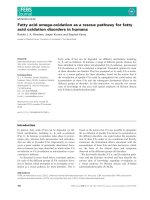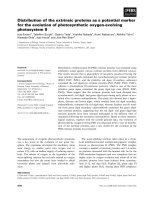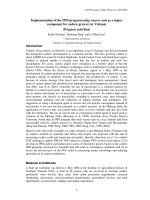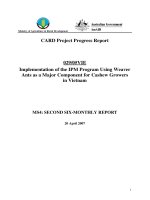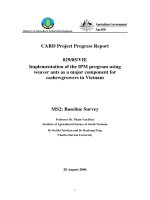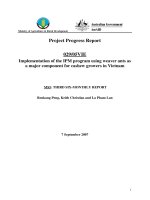BARRIER DISRUPTION IN STAT6VT TRANSGENIC MICE AS A POTENTIAL MODEL FOR ATOPIC DERMATITIS SKIN INFLAMMATION
Bạn đang xem bản rút gọn của tài liệu. Xem và tải ngay bản đầy đủ của tài liệu tại đây (1.14 MB, 50 trang )
BARRIER DISRUPTION IN STAT6VT TRANSGENIC MICE AS A
POTENTIAL MODEL FOR ATOPIC DERMATITIS
SKIN INFLAMMATION
Sonia Cristina DaSilva
Submitted to the faculty of the University Graduate School
in partial fulfillment of the requirements
for the degree
Master of Science
in the Department of Biochemistry and Molecular Biology,
Indiana University
November 2010
ii
Accepted by the Faculty of Indiana University, in partial
fulfillment of the requirements for the degree of Master of Science.
Dan F. Spandau, Ph.D., Chair
Jeffrey B. Travers, M.D., Ph.D.
Master’s Thesis
Committee
Raymond Konger, M.D.
Sonal Sanghani, Ph.D.
iii
This is dedicated to my parents, and my best friends Jorge & Tim…
“There are only two mistakes one can make along the road to truth;
not going all the way, and not starting”
– Siddhartha Gautama, Buddha
iv
Acknowledgments
“We don't accomplish anything in this world alone ”
-Sandra Day O’Connor, U.S. Supreme Court
I would like to thank Dr. Jeffrey Travers for his constant mentorship,
understanding, and confidence in me. Thank you for the opportunity to shadow you in
your AD clinic. I would also like to thank Dr. Dan Spandau and Dr. Raymond Konger
for the constant encouragement and their utter patience. I owe my gratitude to Dr. Sonal
Sanghani for educating me in all the biotechnological techniques that I used in pursuit of
my degree. I am very fortunate to have wonderful mentors guiding me and willing to let
me interrupt their work with my questions.
I would also like to thank Dr. Mark Kaplan for generously providing me with the
STAT6VT transgenic mice, and Dr. Michael Southall for hosting me at Johnson &
Johnson, NJ.
I thank all the members of the labs where I completed each segment of my project
and were instrumental to the technical aspects of this project. For Dr. Ravi Sahu, Dr.
Mohammed Al-Hassani, Dr. Sarita Sehra, Dr. Simarna Kaur, Qiaofang Yi, Davina A.
Lewis, Badri M. Rashid, Evelyn T. Nguyen, and Pamela Durant.
And finally, to Tim, I owe my sincerest gratitude for encouraging me every time
that I thought I had lost it. You gave me comfort and hope whenever I needed it.
v
Table of Contents
List of Tables……………………………………………….……………… ………… vi
List of Figures……………………………………………….……………… ………… vii
Abbreviations……………………………………………….……………… ………… viii
Introduction….……………….………………………………………… ………… 1
Materials and Methods….…….…………………………………….…………… 11
Results………………….…….……………………………………………… …… 18
Discussion…………….…………………………………………………….………… 23
Figures… ………….………………………………………………….…………… 28
References… ………….……………………………………………………….……… 35
Curriculum Vitae
vi
List of Tables
Table 1 Inflammatory cytokine protein expression in STAT6VT transgenic mice
treated with repeated SLS.
vii
List of Figures
Fig. 1 TEWL is augmented in STAT6VT transgenic mice with repeated SLS
irritation.
Fig. 2 Barrier disruption in WT versus STAT6VT transgenic mice following
repeated SLS treatment.
Fig. 3 STAT6VT mice exhibit enhanced inflammation in the shaved dorsal
epidermis following repetitive SLS application.
Fig. 4 STAT6VT transgenic mice feature augmented hyperplasia and active
proliferation following repeated SLS treatment.
Fig. 5 Effect of SLS on EDC genes in WT versus STAT6VT transgenic mice.
Fig. 6 Effect of SLS on inflammatory cytokine gene expression in WT versus
STAT6VT transgenic mice.
viii
Abbreviations
AD atopic dermatitis
BCA bicinchoninic acid
cDNA complementary deoxyribonucleic acid
CE cornified envelope
EDC epidermal differentiation complex
FLG filaggrin
GM-CSF granulocyte-macrophage colony-stimulating factor
IFNγ interferon gamma
ICD irritant contact dermatitis
IL-1ß interleukin-1 beta
IL-4 interleukin-4
IL-12 interleukin-12
IL-13 interleukin-13
IVL involucrin
JAK Janus kinase
KLK7 kallikrein 7
KRT14 keratin 14
KO knockout
LOR loricrin
PBS phosphate buffered saline
PCR polymerase chain reaction
qRT-PCR quantitative real-time polymerase chain reaction
SPINK5 serine peptidase inhibitor Kazal type 5
SH2 Src homology domain 2
STAT6 signal transducer and activator of transcription 6
STAT6VT STAT6 V547A/T548A mutation
SC stratum corneum
TBS tris buffered saline
TEWL transepidermal water loss
T
H
1 T-helper Type 1 cells
T
H
2 T-helper Type 2 cells
TNFα tumor necrosis factor alpha
WT wild-type
1
Introduction
Atopic dermatitis (AD) is a pruritic, chronic inflammatory skin disease with a
lifetime prevalence of 10-20% in children and 1-3% in adults, worldwide. It is the most
common cause of occupational skin disease in adults. In the past three decades,
prevalence of the disease has increased by two to three-fold in industrialized countries,
with higher incidences in urban regions compared to rural regions (Leung & Bieber,
2003). A recent review has described how AD impacts both the child and immediate
family (Sehra, et al., 2008). The pruritic feature of AD can cause mental exhaustion,
mood changes, lack of concentration in school or work, and an increase in parental and
child morbidity. The clinical features of AD include mild cases of erythema in localized
areas of the body to acute lesions that appear as erythematous macules. Lesions tend to
occur on the cheeks, scalp and extensor areas of the arms and legs in infants, and in the
flexural regions of the extremities in older children (Sehra, et al., 2008). The
pathogenesis of AD includes complex interactions between susceptibility genes,
environment, and immunological factors (Leung, 2000). Although recent studies have
resulted in an enhanced understanding of the pathogenesis of AD, there is still a need for
an improved elucidative animal model.
The systemic immune response of AD involves an increase in blood serum IgE
antibodies to nonpathogenic allergens and a decrease in interferon γ levels (IFNγ).
Approximately 80% of children with AD will develop either allergic rhinitis or asthma
(Leung & Bieber, 2003). Biopsy samples from unaffected skin of patients with AD,
compared to healthy, normal skin, show an increase in the number of T
H
2 cells that
regulate interleukin-4 and interleukin-13 (IL-4, IL-13, respectively) (Hamid, et al., 1996).
2
Histologically, there are differences between acute and chronic atopic dermatitis.
Acute AD lesions demonstrate focal parakeratosis, spongiosis of the epidermis, and
inflammatory cell filtrates in the dermis made up of T-cells expressing IL-4 and IL-13,
inflammatory dendritic epidermal cells, macrophages, eosinophils, mast cells, and
antigen-presenting cells like Langerhans cells. On the other hand, chronic AD shows a
less pronounced dermal infiltrate and a significant reduction in IL-4 and IL-13
expression. Interleukin-5 (IL-5), granulocyte-macrophage colony-stimulating factor
(GM-CSF), interleukin-12 (IL-12), and IFNγ are also increased in comparison to the
acute phase of AD and there is acanthosis (Dubrac, Schmuth, & Ebner). The increase in
IL-5 is generally seen during the transition from acute to chronic AD and may be
responsible for prolonged eosinophil survival and function (Hamid, Boguniewicz, &
Leung, 1994).
Those with a history of AD are more prone to developing irritant contact
dermatitis (ICD) of the hands. The clinical result of ICD is inflammation caused by the
release of proinflammatory cytokines from keratinocytes in response to chemical stimuli
(Hogan, 1990). Naive T-cells will differentiate into having either a Type 1 or Type 2
helper T cell phenotype, (T
H
1 or T
H
2 respectively), depending on the source of antigen-
presenting cells. Generally, the T
H
1 pathway is stimulated in response to intravesicular
pathogens in response to infected macrophages. On the other hand, T
H
2 cells are
generated when basophils present antigen to the T cell receptor triggering antibody
production in B-cells (Kaiko, Horvat, Beagley, & Hansbro, 2008).
The skin is responsible for preventing loss of water from the body as well
deterring the entry of environmental particulates. The function of the epidermal
3
permeability barrier is characterized by the stratum corneum (SC); a complex made up of
intracellular lipids, corneocytes, and a structural arrangement (Nielsen, 2000). The SC
has been likened to a brick wall, with the corneocytes acting as the brick and the lipid
intracellular matrix as the cement. During epidermal differentiation, there is a reduction
in phospholipids but an increase in fatty acids and ceramides. The final stages of
epidermal differentiation are marked by the discharge of lipid-containing granules, or
lamellar bodies, from the keratinocytes into the extracellular spaces in the upper granular
layer, forming intercellular membrane bilayers (Loden, 1995).
Skin transepidermal water loss (TEWL) is the rate at which water travels from the
viable dermal and epidermal tissues through the SC to the external environment. It is a
widely accepted technique to evaluate the integrity of the SC and used to study skin
barrier function (Loden, 1995). TEWL (g/hm
2
) can be evaluated with a Tewameter® TM
300 (Courage + Khazaka electronic GMB, Cologne, Germany). It is important that
certain considerations be taken into account, as published by the Standardization Group
of the European Society of contact dermatitis, specifically room temperature and ambient
humidity. Air convection may interfere with the readings, so they should be taken in a
draught protected area such as a hood (Pinnagoda, Tupker, Agner, & Serup, 1990).
TEWL measurements can be used to monitor barrier repair as a function of time. An
increase in TEWL is an indicator of skin barrier dysfunction (Loden, 1995).
Skin erythema is caused by dilation of the blood vessels with an infiltration of
blood cells close to the skin surface and can be elicited by detergents, allergens or UV
light. Erythema is a major assessment in determining the irritation potential of a
compound, and is typically determined by a visual score. Certain factors can skew this
4
score including skin color, scorer subjectivity, and reproducibility between experiments
(Ahmad Fadzil, Ihtatho, Mohd Affandi, & Hussein, 2009). A noninvasive bioengineered
tool that measures erythema is the Mexameter® MX18 (Courage + Khazaka electronic
GMB, Cologne, Germany).
Intact skin barrier is dependent on undisturbed epidermal differentiation which is
coded for by a cluster of genes termed the epidermal differentiation complex (EDC).
Variation within the EDC plays a major role in the pathogenesis of AD. Microarray
analysis of AD lesions have indicated altered gene expression of genes in the EDC,
specifically downregulation of filament aggregating protein or filaggrin (FLG) and
loricrin (LOR) (Hoffjan & Stemmler, 2007).
The EDC spans 1.62 megabases on Chromosome 1q21.3 and contains about 50
genes that are directly involved in the barrier function. These genes encode proteins
including (pro)filaggrin, involucrin, and loricrin. (Toulza, et al., 2007).
FLG is the gene for the protein profilaggrin which is cleaved in the suprabasal
keratinocytes in a complex biochemical cascade involving phosphatases and proteases
into the active form filaggrin (FLG) (Koch, et al., 2000). FLG has a high affinity for
keratins and bundles the keratin intermediate filaments into packs (Koch, et al., 2000;
Sehra, et al., 2008). In the SC, FLG is eventually completely hydrolyzed freeing amino
acids that are thought to contribute to water retention in the SC (Koch, et al., 2000).
Loss-of-function mutations in FLG have been correlated to atopic dermatitis (Torma,
Lindberg, & Berne, 2008). In addition, the abnormal skin barrier seen in patients with a
FLG null mutation and AD and T
H
2 polarization may be caused partly by an elevated
allergen penetration through the skin (Leung, 2009). On the other hand, overexpression
5
of murine filaggrin (Flg) in a transgenic model has been shown to accelerate the rate of
barrier repair following chemical disruption (Presland, et al., 2004).
IVL and LOR encode for involucrin (IVL) and loricrin (LOR), respectively, which
have been shown to facilitate terminal differentiation of the epidermis and skin barrier
formation (Kim, Leung, Boguniewicz, & Howell, 2008). LOR is a major protein
(constituting up to 70% of mass in mice) of the epidermal cornified cell envelope (CE)
found in terminally differentiated epidermal cells. The CE acts as a lamellar structure
that is essential for the barrier function of the skin, preventing the loss of water and ions
and providing protection from environmental factors (Koch, et al., 2000). IVL is also
found in the CE and acts as a scaffold to which other proteins become cross-linked (Kim,
et al., 2008).
KRT14 is responsible for encoding keratin, type 1 cytoskeletal 14, or keratin-14
(KRT14), an intermediate filament protein that forms the structural framework of certain
cells including those that make up skin, hair and nails ("Keratin, type 1 cytoskeletal 14,"
2010). KRT14 is expressed in the basal layer of stratified squamous epithelia,
specifically in the epidermis (Rosenberg, RayChaudhury, Shows, Le Beau, & Fuchs,
1988).
SPINK5 encodes a multidomain serine peptidase inhibitor Kazal type 5 that
contains 15 potential inhibitory domains. A recent study of Caucasian AD families
showed that maternally derived alleles of the SPINK5 gene are associated with
development of AD and asthma.
The role of the innate immune system has been studied in the pathogenesis of AD
(Niebuhr, Lutat, Sigel, & Werfel, 2009). It is known that white blood cells, specifically
6
macrophages accumulate in the inflamed skin of both acute and chronic AD lesions
(Kiekens, et al., 2001). Macrophages differentiate from blood-derived monocytes in situ
and are responsible for the phagocytosis of invading pathogens and dead cells, as well as
the stimulation of cytokines. The cytokines constitute a diverse group of soluble proteins
and peptides that act as regulators of individual cells and tissues under both normal and
pathological conditions. Furthermore, they mediate intracellular interactions as well as
processes occurring in the extracellular environment. Cytokines behave similarly to
hormones by acting at a systemic level by affecting inflammation. However, they differ
from classic hormones in that they act on a wider range of target cells, and are not
produced by specialized cells that are organized in specialized glands. They are
classified as lymphokines, interferons, colony stimulating factors, and chemokines
(Balkwill & Balkwill, 2000). Macrophages are an important source of proinflammatory
mediators including IL-1ß, TNFα, IL-6, CXCL8 (Bloemen, et al., 2007).
Early events in atopic skin inflammation involve mechanical trauma and skin
barrier disruption resulting in a rapid upregulation of the proinflammatory cytokines IL-
1α, IL-1ß, TNFα and GM-CSF (Homey, Steinhoff, Ruzicka, & Leung, 2006). The
relative contribution of an individual cytokine is dependent on the duration of the skin
lesion, thus implicating both T
H
1 and T
H
2 cytokines in the pathogenesis of skin
inflammation exhibited in AD (Werfel, 2009). Studies have shown that IFNγ is
upregulated in spontaneous or older lesions in AD (Grewe, et al., 1995). AD patients
have activated T-cells that express high levels of IFNγ that undergo apoptosis in
circulation, skewing the immune response towards a T
H
2 phenotype. This provides a
7
mechanism for the T
H
2 predominance seen in the circulation and in acute AD lesions
(Akkoc, et al., 2008).
The cytokine IL-4 plays a critical role in the pathosphysiology of asthma and
allergic diseases. The IL-4 pathway cascade is mediated through the activation of the
latent transcription factor, signal transducer and activator of transcription 6 (STAT6).
The STAT proteins consist of 750 to 800 amino acid residues and contain a Src
homology 2 (SH2) domain and a carboxyl-terminal tyrosine phosphorylation site. Seven
STAT proteins have been identified. STAT proteins require both tyrosine
phosphorylation for dimerization and translocation to the nucleus and serine
phosphorylation for transcriptional activation (Akira, 1999).
STAT6 is a monomeric protein that is activated by the Jak/STAT pathway. When
IL-4 binds to its receptor, the Jaks phosphorylate tyrosine residues in the IL-4Rα and γc
receptor chains, recruiting STAT6 to the IL-4Rα chain (Bruns, Schindler, & Kaplan,
2003). The STAT6 SH2 domain is integral to its interaction with the two
phosphotyrosine-containing regions in IL-4. As a result, STAT6 becomes
phosphorylated on tyrosine 641 by Jak1 and/or Jak3 (Jak family of tyrosine kinases).
The phosphorylated monomers then dimerize and migrate to the nucleus, where STAT6
binds cis-acting elements to activate the transcription of IL-4 target genes (Daniel,
Salvekar, & Schindler, 2000). Previous experiments using STAT6 -deficient mice have
shown that most IL-4 mediated functions are lost with the absence of STAT6 (Bruns, et
al., 2003). These losses of function include the inability to regulate Ig isotype expression
by promoting a class switch to IgE and IgG1 in antigen-activated B cells. In addition,
there is no induction of IL-4-induced cell surface markers, and lymphocytes have
8
impaired proliferative responses to IL-4. Finally, the STAT6-deficient mice cannot
promote the differentiation of naïve CD4
+
T-cells into the T
H
2 phenotype (Bruns, et al.,
2003).
Mice with an activating mutation in STAT6, known as STAT6VT, constitutively
express STAT6 in T-cells. The difference between STAT6VT and wild-type (WT) mice
is that the mutant contains two residue substitutions at positions V625A and T626A in the
SH2 domain. The STAT6VT is constitutively phosphorylated on the critical tyrosine
residue, Y641, and transcriptionally active in the absence of IL-4. The conformational
change in the protein caused by the mutation hinders the association of STAT6VT with
the unphosphorylated IL-4R chains (Bruns, et al., 2003).
The ability of the constitutively active STAT6 to mimic the IL-4 activated
functions in vivo was evaluated by generating a transgenic mouse that expressed
STAT6VT only in lymphoid tissues; it was engineered using a C-terminal FLAG tag.
The vector containing the STAT6VT cDNA was digested with EcoRI, and the fragment
was cloned into VACD2, a plasmid containing the CD2 locus control region (LCR).
Next, the CD2: STAT6VT vector was digested with KpnI and XbaI, resulting in a 15.7 kb
fragment that was purified and used to generate the transgenic mice. The resulting mice
contain a conformational change in the STAT6 protein that allows for it to be
phosphorylated, bind DNA and activate transcription independent of IL-4 stimulation.
The STAT6VT transgenic mice have altered lymphocytic behavior. The expression of
STAT6VT in the B lymphocytes causes increased expression of IL-4 related inducibility
and increased production of IgG1 and IgE, but no activation of the B lymphocytes. The
same STAT6VT expression in the T lymphocytes results in T cell differentiation towards
9
a T
H
2 phenotype (Daniel, et al., 2000). The STAT6VT transgenic mice develop AD
symptoms under specific pathogen-free conditions and do not require overexpression of
effectors in the skin.
Sodium lauryl sulfate (SLS), an anionic detergent, is a common ingredient found
in soaps, shampoos, and various other skin care products. It has been shown to trigger a
prolonged barrier disruption of the skin that lasts up to a week following a single 24-hour
application. SLS is commonly used in studies involving skin barrier damage (Patil,
Singh, Sarasour, & Maibach, 1995; Torma, et al., 2008). The underlying molecular
mechanisms to explain barrier repair after chemical disruption of the skin are currently
limited, although it is known that altered keratinocyte differentiation may occur (Ponec &
Kempenaar, 1995). SLS penetrates the skin to a depth of 5-6mm below the site of
application in a hairless rat model (Patil, Singh, Sarasour, et al., 1995). The radial spread
of SLS can elicit increased TEWL and decreased skin capacitance in areas adjacent to the
application sites, as far as approximately 0.75cm away (Patil, Singh, & Maibach, 1995).
It appears that SLS acts in a time-and-dose dependent manner to disrupt the barrier
function (Nielsen, 2000). The goal of the present studies was to assess the effects of
topical SLS on skin in normal and STAT6VT mice. Our hypothesis is that treatment of
STAT6VT mice, at a young age where they have no clinical abnormalities, with SLS will
result in an increased barrier disruption in comparison to WT mice. Our preliminary data
suggests significant differences between the STAT6VT transgenic mice from WT
littermate controls treated with SLS. These findings correlate with evidence that there are
abnormalities in the barrier function between these mice (Sehra, et al., 2010).
10
Polymerase chain reaction (PCR) is a standard laboratory technique that amplifies
a specific DNA sequence in vitro (Mullis, 1990). Quantitative real-time PCR (qRT-PCR)
is used to determine the copy number of target DNA in a particular sample. Taqman
PCR is a probe-based system that uses a fluorogenic probe containing a reporter
fluorescent dye and a quencher dye to provide a fast and reliable method for semi-
quantitative analysis of gene expression (Medhurst, et al., 2000). Cytokine analysis of
several analytes can be done simultaneously using an array system based on Luminex®
xMAP technology. This method is based on flowmetric analysis of beads acting as a
solid support for individual reactions using a common fluorophore reporter. The
measurement of an array of cytokines is important for studying inflammatory diseases
and diseases of unknown etiology (Skogstrand, et al., 2005). The bicinchoninic acid
(BCA) assay is a colorimetric assay used to quantify the amount of protein in a sample
(Sapan, Lundblad, & Price, 1999).
11
Materials and Methods
Wild-type (WT) and STAT6VT transgenic mice
The STAT6VT transgenic mice have been generously provided by Dr. Mark
Kaplan at Indiana University School of Medicine, Indianapolis, IN for our breeding
purposes. These heterozygous mice were bred with C57BL/6 mice (Harlan Laboratories,
Indianapolis, IN) to generate additional transgenic mice and WT controls. All mice were
maintained in standard microisolator cages under a simulated 12-hour day/night cycle
and were fed and watered ad libitum. All animal experiments were in compliance with
and approved by the Indiana University School of Medicine Animal Care and Use
Committee.
Mouse Genotyping using a Taq Polymerase
PCR-quality mouse genomic DNA was prepared by using a hot sodium hydroxide
and tris (HotSHOT) method. Mouse tail snips (0.2-0.5 cm long) were collected into 0.5
ml PCR tubes and placed on ice. If lysis could not be done immediately, the tails were
placed at -20
o
C for storage. The stock reagents include an alkaline lysis reagent prepared
with 25 mM NaOH, 0.2 mM disodium EDTA (pH=12) dissolved in water without
adjusting the pH; and a neutralizing reagent of 40 mM Tris-HCl (pH=5) also dissolved in
water without adjusting the pH. Next, 0.75 µl of the alkaline lysis was added to the tail
snip, heated to 95
o
C for 30 minutes, and cooled to 4
o
C. Then 0.75 µl of neutralizing
reagent was added, spun down and either used immediately or the supernatant was stored
at -20
o
C (Truett, et al., 2000). The PCR conditions to screen for the STAT6VT transgene
(5′ sequence: gcctaccatggtgccttcttatg, 3′ sequence: tatgcttgtcatcgtcgtccttgtagtcac)
12
consisted of a 1 minute denaturation step at 94
o
C and 34 cycles of 94
o
C for 20 s, 58
o
C for
30 s, and 72
o
C for 45 s.
Induction of chronic irritation and biophysical measurements
The development of chronic atopic symptoms in mice was induced by treating the
intact dorsal skin of both STAT6VT and WT sibling controls with 0.1 ml of a 5%
aqueous solution of sodium lauryl sulfate (BioRad Laboratories Inc., Hercules, CA) and
distilled water (vehicle). The animals were kept in clean rooms with controlled
temperature (22±2
o
C) and humidity (35-40%), and lit with a 12-hour on/off cycle.
Female mice were used in all experiments unless otherwise indicated. Approximately
two to three mice were assigned to each of the following four groups: STAT6VT
Vehicle, WT Vehicle, STAT6VT SLS and WT SLS during each of the three experiment
trials. The SLS was applied in a regime of three sets of daily exposure for six
consecutive exposures followed by a 14-day period with no application. On Day 0, the
mice were briefly anesthetized with ketamine/xylazine (80/10 µg/kg body weight)
intraperitoneally and the dorsal hair was shaved. Twenty-four hours later, baseline
transepidermal water loss (TEWL, g/hm
2
) measurements were taken with a Multi Probe
Adapter (MPA) fitted with a TM300 Tewameter (Courage + Khazaka, Cologne,
Germany), and 0.1 ml 5% SLS was applied topically to irritate the skin. Subsequent
TEWL readings were taken daily during the application time course, and every other day
during non-application days. The same sample size of WT sibling control mice were
treated similarly. A final six day treatment period of 10% SLS was done. The accepted
practice of TEWL measurement using an open chamber system is based on assessing the
13
vapor pressure that builds up inside the probe tunnel when it is placed on the skin surface.
To minimize the possible errors of this method caused by fluctuations in the relative
humidity and skin surface temperature, standard procedures were followed. All
measurements were performed at standard laboratory conditions (temperature of 20-25
o
C
and humidity of 30-40%). The probe was applied so that it was in full contact on the
dorsal median and the probe temperature was given time to acclimate to the skin
temperature (approximately 20 s). The change in TEWL for each mouse was compared
to each individual mouse’s baseline value and the fold increase was plotted.
Tissue Processing
The dorsal skin of age-matched mice (STAT6VT and WT) that was treated with
SLS or water was harvested within 72 hours following the final treatment. The skin
tissue was processed for each of the following: tissue was harvested and preserved in
RNAlater RNA Stabilization Reagent (Qiagen, Valencia, CA) for qRT-PCR analysis, 7
mm skin biopsies were harvested to assess cytokine levels, and 0.5 cm
2
skin sections
were harvested and fixed in 10% neutral buffered formalin for 1.5 hours for paraffin-
embedding and histologic assessment and immunohistochemical analysis. The remaining
tissue was snap-frozen in liquid nitrogen and stored at -80
o
C.
Immunohistochemistry for Ki-67 and quantification of positive staining
Mouse dorsal skin sections were formalin-fixed for 1.5 hours and changed to 70%
EtOH, trimmed and placed in cassettes for further processing and embedding. For Ki-67
immunolabeling, standard deparaffinization and hydration were performed followed by
14
heat-induced antigen retrieval using 10 mM citrate buffer, pH 6.0 for 20 min. All
reagents were purchased from DAKO, Carpinteria, CA unless otherwise noted. Sections
were incubated with 3% hydrogen peroxide for 10 min at room temperature. Sections
were washed with TBS followed by incubation with Ki-67 (SP6) (Thermo Scientific).
The sections were then washed and incubated with Envision+ System-HRP (DAB) for
use with rabbit primary antibodies for 30 min at room temperature. DAB+ was used for
substrate detection. Sections were then counterstained and mounted. All images taken
with a Nikon Eclipse E400 microscope (Nikon Corp., Melville, NY) at 200X
magnification were saved as .tiff files and subjected to a background subtraction in NIH
Image J. For the background subtraction, the light background, separate colors, and
sliding parabaloid functions were checked. The images were opened in Metamorph Meta
Imaging Series 7.5 (Molecular Devices, Downington, PA). In Metamorph, the epidermis
was selected using the region drawing tool and the images were color separated into blue,
red, and green images. For thresholding on Ki-67 positive cells as a percentage of the
total epidermal area, the blue image was utilized. Total epidermal nuclei were estimated
by thresholding on a grayscale image in Metamorph. All images were analyzed using the
same threshold settings for K-i67 and total nuclei. Results are shown as the ratio of Ki-
67 positive thresholding relative to total epidermal nuclei.
Quantification of epidermal thickness by IHC
Changes in overall morphology were visualized following hematoxylin and eosin
(H&E) staining of paraffin-embedded tissue samples. Epidermal thickness was measured
by an optical micrometer in a blinded manner using a Nikon Eclipse E400 microscope at
15
200X total magnification. Measurements (µm) were taken from the base of the stratum
corneum to the basement membrane of the inter-rete ridges along the entire length of
each section, in 3 random fields in an observer-blinded manner for each condition.
Total RNA extraction and cDNA synthesis
To quantify the relative gene expression for each mouse, the skin tissue preserved
in RNAlater was first weighed (<30mg) and total RNA was isolated using the RNeasy
Fibrous Mini Kit (QIAGEN Inc, Valencia, CA). The skin tissue was disrupted and
homogenized in Buffer RLT with ß-Mercaptoethanol and a stainless steel bead (5 mm
mean diameter) with a TissueLyser (QIAGEN Inc, Valencia, CA) for three repeated
bursts of 2 min at 20 Hz. After a proteinase K digestion step, DNase was used to remove
any traces of DNA that may copurify with the total RNA. The eluate was collected and
the concentration of total RNA(1 µl) was determined by using a NanoDrop 2000 UV-Vis
spectrophotometer (Thermo Scientific, Wilmington, DE) at 280 nm, and all samples were
blanked with 1 µl of RNase-free water. RNA (0.85 µg) was reverse-transcribed in a 20
µl reaction containing Random Primers (50 ng/µl: Invitrogen, Carlsbad, CA), dNTP (10
mmol/L; Invitrogen) with a 5 min denaturation step at 65
o
C; then 10X First Strand RT
buffer (Invitrogen), DTT (0.1 mol/L; Invitrogen), Superscript III RT enzyme (200 U/µl;
Invitrogen) for 10 min at 25
o
C, 50 min at 50
o
C and 5 min at 85
o
C; and RNase H
(Invitrogen) for 20 min at 37
o
C. The cDNA was either stored at -20
o
C or used for qRT-
PCR immediately.
16
Quantitative real-time PCR
Relative gene expression was studied by qRT-PCR in a 10 µl volume reaction in
MicroAmp® 96-well reaction optical tubes in the 7900HT Fast Sequence Detection
System (Applied Biosystems, Stockholm, Sweden). cDNA was used as template (0.85
µg total RNA) along with a dual-labeled fluorogenic probe method using Taqman
primers. All primers and probes for murine genes were purchased from Applied
Biosystems. Relative gene expression levels were calculated using the ΔΔC
T
method.
Quantities of all targets in each sample were normalized to the corresponding Krt14 in
the skin biopsies.
Cytokine analysis
Punch biopsies of 7 mm diameter were taken from mouse dorsal skin that had
been challenged with SLS or vehicle and stored at -80
o
C. The skin was minced on a
glass plate using a razor blade and homogenized on ice in 800 µl cold PBS containing
protease inhibitor cocktail and 0.1% Triton X-100 (Sigma Aldrich, St Louis, MO). The
samples were centrifuged at 1000 RPM for 10 min at 4
o
C and the supernatant was used
for cytokine analysis. Cytokine and chemokine analysis for murine GM-CSF, IFNγ, IL-
10, IL-12 (p70), IL-13, IL-1β, IL-2, IL-4, IL-5, IL-6, IL-7, MCP-1, and TNFα was done
using the MILLIPLEX™ MAP cytokine and chemokine panel, based on the Luminex
xMAP platform (Millipore, Billerica, MA) at Johnson & Johnson, Skillman, NJ.
17
Normalization of protein levels
Cytokine levels were normalized to total protein levels determined by a Pierce
BCA protein assay kit (Thermo Scientific, Rockford, IL.). 10 µl of all standards and
samples were diluted in 200 µl of the BCA working reagent (50:1, Reagent A: B) to yield
a sample to working ratio of 1:20) in a microplate. The standards used were known
concentrations of bovine serum albumin (BSA) diluted in the same homogenization
solution given above. Plate was covered and incubated at 37
o
C for 30 min. The
absorbance for both the standards and the samples were read at 562 nm in a Beckman
spectrophotometer blanked with 800 µl cold PBS containing protease inhibitor cocktail
and 0.1% Triton X-100 and 200 µl of BCA working reagent. The absorbance values for
the standards were plotted using Microsoft Excel for a linear regression fit to generate a
standard curve from which the protein concentration of experimental standards could be
determined.
Statistics
Statistical analysis was conducted using Graph Pad Prism, version 5.0 (San
Diego, CA). Statistical differences between groups were determined using the student t-
test with significant differences conferred when p<0.05. In cases where multiple groups
were compared, data were analyzed by a one-way analysis of variance (ANOVA).
Where the direction of change was known, a one-tailed student t-test was employed.


